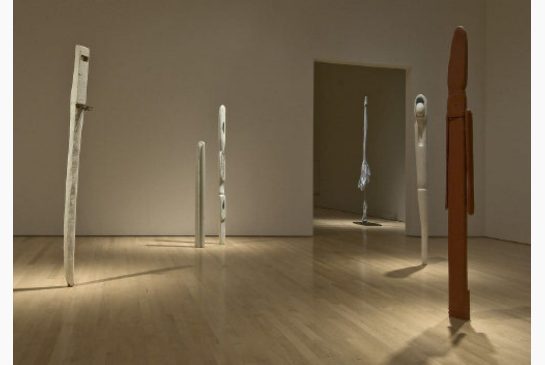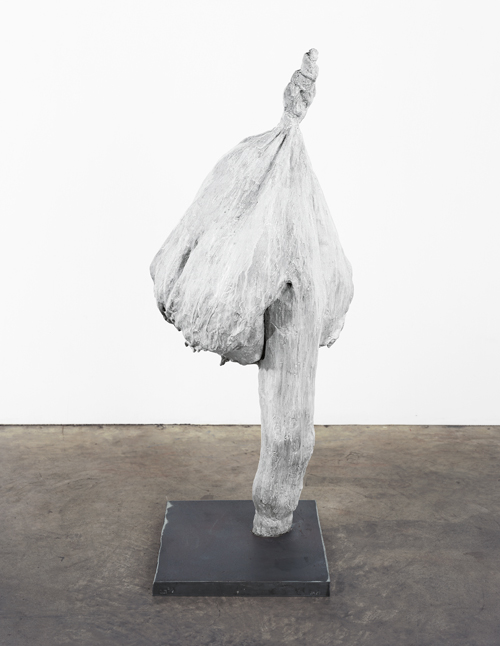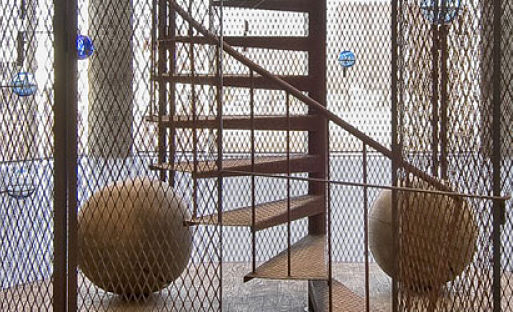When she passed away in 2010, Louise Bourgeois left behind one of the most varied and distinct artistic oeuvres of the last century. Paying homage to this long and remarkable career, the Museum of Contemporary Canadian Art (MOCCA) is currently showing a retrospective of the artist titled Louise Bourgeois 1911-2010. The exhibition is compact, featuring selected pieces from four distinct bodies of work. But even in its brevity, the retrospective offers an insightful glimpse into the fecundity of Bourgeois’ imagination and the unabashed intimacy of her art.
 Installation view of Louise Bourgeois (1911-2010): works from the Personages series and Forêt (Night Garden). Collections NGC and Louise Bourgeois Trust, courtesy Cheim & Read Gallery, New York, and Hauser & Wirth Gallery, London. © Louise Bourgeois Trust. Photo © NGC.
Installation view of Louise Bourgeois (1911-2010): works from the Personages series and Forêt (Night Garden). Collections NGC and Louise Bourgeois Trust, courtesy Cheim & Read Gallery, New York, and Hauser & Wirth Gallery, London. © Louise Bourgeois Trust. Photo © NGC.
The exhibition opens with over a dozen slender, wooden totems from Bourgeois’ early career. These slender creations are part of over 80 sculptures she produced in the late 1940s and early 1950s, after her move to the United States. Referred to as “personages,” these wooden characters are embodiments of the people she left behind in Europe, and those whom she came to know in New York. Many of these personages are psychologically charged, and not all of them are friendly. In the anthropomorphic Portrait of C.Y., for example, multiple nails have been driven into its chest area, eliciting a silent scream from a rectangular opening in the upper part of the totem.
These animistic sculptures suggest the influence of “primitivism” – particularly wooden African fetishes – but they also evoke ties with various other European sculptural developments of the early twentieth century. Growing up in an affluent family in the outskirts of Paris, Bourgeois was surrounded by a rich visual culture of neo-classical garden sculptures, trendy decorative arts, and nineteenth century masterpieces by the Romantics to the Post-Impressionists. While she assimilated these early sources of inspiration and was always responsive to new artistic developments, she resisted being engulfed into any one style or movement. Bourgeois spoke with a visual language unique to herself, and which was continually evolving but always according to her own rules.
 Installation view of Louise Bourgeois (1911-2010): works from the Personages series and Forêt (Night Garden). Collections NGC and Louise Bourgeois Trust, courtesy Cheim & Read Gallery, New York, and Hauser & Wirth Gallery, London. © Louise Bourgeois Trust. Photo © NGC
Installation view of Louise Bourgeois (1911-2010): works from the Personages series and Forêt (Night Garden). Collections NGC and Louise Bourgeois Trust, courtesy Cheim & Read Gallery, New York, and Hauser & Wirth Gallery, London. © Louise Bourgeois Trust. Photo © NGC
It is worth noting that this MOCCA exhibition displays the personages as they were originally intended to be, rather than on metal bases as they often are; each of the wooden sculptures are installed directly onto the floor without visible support, some congregating in clusters and others standing on their own. The curator has thus transformed the space into a cocktail party of zany characters, inviting the viewer to snake through the social gathering and interact with the wooden guests. Bourgeois’ interactive arrangement of these sculptures was certainly ahead of its time, preceding similar queries undertaken by Minimalism and installation art later on.
 Louise Bourgeois, Echo IV, 2007, Bronze, painted white, and steel, Collection Louise Bourgeois Trust, courtesy Cheim & Read Gallery, New York and Hauser & Wirth Gallery, London. © Louise Bourgeois Trust. Photo: Christopher Burks.
Louise Bourgeois, Echo IV, 2007, Bronze, painted white, and steel, Collection Louise Bourgeois Trust, courtesy Cheim & Read Gallery, New York and Hauser & Wirth Gallery, London. © Louise Bourgeois Trust. Photo: Christopher Burks.
The next body of work on display fast-forwards fifty years. These half a dozen grey, biomorphic sculptures are part of the Echoes series executed in her late career in 2007. These sculptures are bronze casts of her old clothing, stretched and reconfigured into strange formations, some cocoon-like, others slender and taught. Bourgeois wrote of the past, “you have to tell your story, and you have to forget your story.” The bronze casts “echo” her personal garments and are frozen embodiments of the memories entwined in them. These works make palpable the artist’s compulsion to create and the cathartic liberation she derived from it.
The last work in the exhibition is also the latest work. The 2008 sculpture Cell (The Last Climb) is placed singly in a spacious room, creating an airy atmosphere for contemplation. This work is one among over twenty sculptures in the Cell series, which she produced over three decades starting in the 1980s. Compared to others in the series, The Last Climb is more serene than impassioned, and more reflective than effusive. This is not to say that Bourgeois’ creative drive had at all simmered, as this cell is as inventive and multifarious in its signification as some of her best work.
 Louise Bourgeois, Cell (The Last Climb), 2008 National Gallery of Canada, Ottawa. © Louise Bourgeois Trust. Photo © National Gallery of Canada
Louise Bourgeois, Cell (The Last Climb), 2008 National Gallery of Canada, Ottawa. © Louise Bourgeois Trust. Photo © National Gallery of Canada
The Last Climb consists of a large-scale, cylindrical wired cage housing a variety of personal and symbolic elements. The staircase spiralling up the centre of the cage is taken from her Brooklyn studio, literally transporting a part of her intimate and creative life inside the cell. A large, wooden teardrop hangs from the ceiling with numerous threads attached to it, each linked like a spider’s silk to an over-sized spool. Threads make a personal allusion to her family’s tapestry business, but they are also a classic metaphor for life and its precariousness. But while threads are helpless in the hands of the Fates, to be spun and cut, spools are also bundles of possibility awaiting creative activity. Bourgeois’ thread imagery thus reads as a moving expression of the creative potentiality of life, which is at the same time fragile and imminently breakable.
 Louise Bourgeois, Cell (The Last Climb) Detail, 2008 National Gallery of Canada, Ottawa. © Louise Bourgeois Trust. Photo © National Gallery of Canada
Louise Bourgeois, Cell (The Last Climb) Detail, 2008 National Gallery of Canada, Ottawa. © Louise Bourgeois Trust. Photo © National Gallery of Canada
The word “cell” itself, while also evoking associations with a prison, makes reference to the simplest form of biological life. In The Last Climb, Bourgeois has borne a visual microcosm of her personal life, filled with feelings and memories most pungent and intimate. As the artist herself put it tersely, “Art is a way of recognizing oneself.” The artist who is recognized in this MOCCA exhibition, however, is one whose identity is as multiform and slippery as her artistic style. Even as it distils her creative output into four sets of work, the exhibition doesn’t so much unveil Louise Bourgeois as it presents her as a complex enigma. Yet amid the dense metaphors and personal symbolism, the works on show reveal brief moments of clarity, as the viewer stumbles unexpectedly into the Heideggerian forest clearing (Lichtung). And so according to Heidegger, it is only in losing one’s way can we find the sunlit clearing.
Amy Luo
* The exhibition is on display till August 11, 2013 at the Museum of Contemporary Canadian Art, located at 952 Queen St W. Gallery hours: Tues–Sun 11:00–6:00 p.m.
